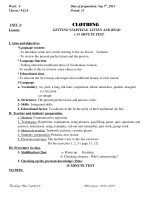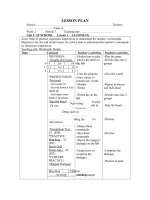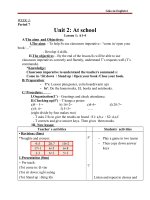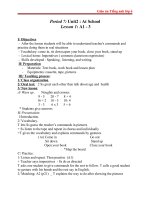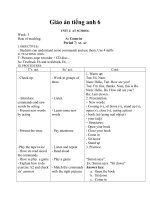Giáo án Tiếng Anh 9 Unit 2: Clothing
Bạn đang xem bản rút gọn của tài liệu. Xem và tải ngay bản đầy đủ của tài liệu tại đây (172.6 KB, 26 trang )
TIẾNG ANH 9 – GIÁO ÁN
Unit 2: CLOTHING
Lesson 1: - Getting started
- Listen & Read
I. Aims:
- Read a text for details.
- Know some more about "Ao Dai", the traditional dress of Vietnamese women.
II. Teaching aids: Textbook, Lesson plan, pictures, real objects
III. Procedure:
Tim Teacher’s activities
e
05m
s
Students’ activities
* Warm up: "QUIZ"
Devide class into 2 groups. Ask them to look
at the clothes people are wearing and take
turn
to decide where each person comes Ss answer:
from.
Ex: T shows picture (a) and asks:
- She comes from Japan
- Because she is wearing a
- Where does she come from?
Kimono.
- Why do you know that?
b- She comes from Vietnam
* Do the same with other pictures.
- Because she is wearing "Ao dai",
the traditional dress of Vietnamese
women
c- He comes from Scotland (UK)
- He is wearing a kilt.
d- She comes from India.
- She is wearing a sari.
e. He comes from the USA
- He is wearing Jeans.
f- She comes from Arabia.
- She is wearing a veil.
13m A. Pre reading:
s
1. Vocabulary: T elicits from Ss:
- a poet: nhà thơ (example: To Huu, Nguyen - Give vocabulary.
Du...) => poem (n): bài thơ
- Repeat chorally (2).
- a long silk tunic: áo lụa dài rộng (real - Repeat individually.
object)
- Give meaning.
- inspiration (n): cảm hứng, hứng khởi
(translation) => to take inspiration from sth:
lấy cảm hứng từ ….
- ethnic minorities: dân tộc thiểu số (example:
Thai, Cham, Ede...)
- pattern (n): hoa văn (picture)
- unique (adj): độc đáo (translation)
* Checking stress
15m
s
* Let Ss copy down
- Checking stress.
- Copy down.
- Checking vocabulary.
* Checking vocabulary: What and where
B. While reading:
* Set the scene: (use real object)
- It’s ao dai.
- What’t this?
- At work or on special occasions.
Yes, It a traditional dress of Vietnamese - Read the text (page 13 - 14)
women. When do women wear ao dai?
silently.
To know well about this clothes, open your - Finish exercise (a) by completing
books and read the text silently then do the sentences. Use the information
exercise (a)
from the passage:
* Correction
a. Complete these sentences:
* Answer key:
1. Poems, novels and songs.
2. Long silk tunic with slits up the sides worn
over loose pants.
3. To wear modern clothing at work.
4. Some designers have modernized the ao
dai by printing lines of poetry on it.
5. Symbols such as suns, stars, crosses and
stripes.
- Read the text again then answer
Ask Ss to read the text the second time to the questions.
answer the questions:
T asks questions, ask Ss to answer:
b. Comprehenson questions:
* Answer key:
1. Traditionally, men and women used to
10m wear the ao dai.
s
2. Because it is more convenient.
+ One S => one answer.
3. They have printed lines of poetry on it or
have added symbols such as sun, stars,
2ms crosses and stripes to the ao dai.
C. Post reading:
Discussion
Use their own words to tell the
Use their own words to tell the group what group what they have known about
they have known about the ao dai.
HOMEWORK : Writing
Ask Ss to write down what they have spoken
to their partner and adding their opinion
whether they like wearing ao dai or not.
* Study the lesson at home.
* Prepare lesson 2 (Speak)/ page 14, 15 of
Unit 2.
the ao dai.
Unit 2: CLOTHING
Lesson 2: Speak (page 14, 15)
I. Aim: .By the end off the lesson, Ss will be able to ask and repond to questions
on personals references
II. Teaching aids: Textbook, lesson plan, pictures, flipcharts.
III. Procedure:
Tim Teacher’s activities
e
07m
s
Students’ activities
* Warm up: "Wordsquare"
Stick the poster on the bb
A
C
P
L
A
I
D
T
F
U
Ask
T
R
I
H
S
A
H
S
I
K
Ss
P L A
I N
G H T Z L
O I K O Y
U E U J R
H S W E A
E H I N G
M O B A G
T R I P E
W T J E A
B S K I R
to find 8 nouns and
B D F
P W Q
A M S
N V L
T E R
S J S
G Y L
D J O
N S T
T B E
4 adjectives
about clothing in the worksquare.
Answer key:
=> sweater, Jeans, skirt, striped, baggy,
plain.
- Play it in 2 groups to find the work
in the worksquare then circle the
words they have found and write
them down in the bb.
The team which has more works than
other will win the games.
Plaid, shorts, pants, shirt..
Blouse
Suit
Presentation:
* Activity 1: Ask Ss to match the phrases
to the pictures.
* Answer key:
a. a colorful T - shirt
b. a sleeveless sweater
c. a striped shirt
d. a plain suit
15m
s
e. faded Jeans
- Look at the pictures and match them
with the phrases (work in 2 groups)
f. a short - sleeved blouse
g. baggy pants
h. a plaid skirt
i. blue shorts
* Checking vocabulary: Kim’s Game
Ask Ss to remember the phrases on pages
14 &15 in 30 seconds.
Then let their books closed.
Divide class into 4 groups.
Ss from each turn to go the bb and write as
many words as they can.
- Work in 4 groups.
* Activity 2:
- Look at the phrases in 30 seconds -
Ask Ss to work in groups of 8 or 10. Ss each Then remember to write on the bb as
to read and write two more questions for the many words as possible.
last section of the survey about students’ Group with the most words wins the
wear.
game.
- The form of the survey may look like this:
QUESTIONS
ITEMS
- Work in groups of 8 or 10. Ss to
E
OF
write 2 more questions for the last
CLOTH section.
13m
s
NAM
ES
1.What do you uaually
wear on the weekend ?
2. Why do you wear
these clothes ?
3. What is your favorite
type
of
clothing
?
Why ?
4. Is it comfortable to
wear uniform ?
5. What color is it ?
6.
What
kind
of
clothing do you usually
wear on Tet holiday ?
7. What would you
wear to a party ?
* Activity 3:
- Ss interview their friends.
Ask Ss to present the result of the survey in
front of the class.
HOMEWORK :
- After finishing their task, report the
* Practise speaking skill.
result of their survey in their group.
08m * Prepare lesson 3 ( Listen/ page 16) of Unit The survey should begin as follow:
s
2.
- Three people said that they liked
their uniform.
02m
- Two people said that they usually
s
wore colorful T-shirt on the weekend.
- Chi said she loved baggy pants.
Unit 2: CLOTHING
Lesson 3: Listen + Language focus 1, 2
I. Aims: By the end of the lesson, Ss will be able to listen for specific information,
describe what people are wearing and know how to use the present perfect.
II. Teaching aids: Textbook, Lesson plan, pictures, real objects
III. Procedure:
Tim Teacher’s activities
Students’ activities
e
05m * Warm up: " Networks"shirt
coat
s
T shirt
* Play it in 2 groups.
Write on the bb the words relating
blouse
to clothing.
CLOTHING
skirt
dress
Jeans
_ Divide class into 2 teams.
- The teams which writes more
- Ss from 2 teams go to the blackboard and words in limited time is the winner.
write the words relating to clothing.
A. Pre Listening:
11m
s
(Use pictures on page 16 / 4)
Look at the pictures and answer:
a. What are these? (Pictures a)
a. They are pants, short and skirt
- What color are they?
- They are yellow, blue and pink.
b. What are they? (Pictures b)
b. They are blouses
- What color are they?
- They are white and pink
c. What are they? (Pictures c)
c. They are shoes.
- What color are they?
- They are blue, red and brown.
1* Vocabulary: T elicits from Ss then models
- announcement (n): thông báo, loan báo (ex)
- Give vocabulary
- missing (adj): mất, thất lạc = lost
- Repeat chorally (2)
- entrance (n): lối vào = gate = exit
- Repeat individually (3)
- fair (n): hội chợ (a place where people or
- Give meaning
company bring their product to display or
sell)
* The whole class check
- attention (n): sự chú ý ( translation)
* Copy down
* Checking stress
* What and Where
* Let Ss copy down
* Checking vocabulary: What and Where
10m B. While Listening:
s
* Set the scene:
Listen to the announcement and
You will hear a public announcement about a answer the questions:
lost little girl called Mary then answer the * Answer
questions:
1. Her name’s Mary.
* Questions:
2. She is three years old.
1. What’s her name ?
3. 20 minutes ago.
2. How old is she ?
4. Near the main entrance to the
3. When was she last seen ?
Car Fair.
4. Where was she last seen ?
5. She has short dark hair.
5. How is her hair ?
Listen again and check the letter of
the correct picture to show what
Ask Ss to listen to the announcement again Mary is wearing.
and check the letter of the correct picture to
show what Mary is wearing.
*Answer key:
a. She is wearing blue short (B)
b. She is wearing a long - sleeved white
7ms blouse (A)
c. She is wearing brown shoes (C).
C. Post Listening:
Describe one of their friends by
Ask Ss to describe a friend of them by
answering the
answering the questions:
questions
- What’s her/his name?
10m
s
- How old is he/ She?
- What is he/ she like?
- What type of clothing does he/ she like
wearing.
* Language Focus: The Present perfect
Read the dialogue on page 19 then
Ask Ss to read the dialogue on page 19 then give form, meaning and use of the
give form, meaning, use and pronunciation.
* Form:
Present perfect tense.
S + Have / has + past participle
* Use: To talk about something that started in
the past and continues up to the present.
We often use for and since with the present
2ms
perfect tense
- For + a period of time
- Since + a point of time
* Practice: Ask Ss to use the
information in the table on page 20 to make
similar dialogues. Then practice them with a
partner.
- Make similar dialogues
T goes around the class, take notes in order to - Practice them with a partner.
help correct Ss’ pronunciation, intonation,
participle of some irregular verbs.
HOMEWORK :
* Write in their notebooks what
* Write in their notebooks what they have they
described to their friends.
have
described
to
their
friends.
* Prepare Lesson 4 ( Read / page 17) of Unit * Prepare Lesson 4 ( Read / page
2 ./.
17) of Unit 2 ./.
Unit 2: CLOTHING
Lesson 4:
Read (page 17, 18 )
I. Aim: By the end of the lesson, Ss will be able to read and understand the text for
details about Jeans.
II. Teaching aids: Textbook, Lesson plan, pictures, real objects
III. Procedure:
Tim Teacher’s activities
e
05m
s
Students’ activities
* Warm up : "Shark attack"
_ _ _ _ _ ( Jeans)
- Draw 5 steps then stick the cut out girl on - Play the game in 2 groups.
top of the steps. The shark is in the sea.
- Have to try to guess any letter of
- Draw 5 gaps for the word " Jeans".
the word.
If their guess is wrong, the girl has
to step down. If their guess is right,
they’ll get 1 mark. The game
continues until Ss find out the word
A. Pre reading:
13m 1. Vocabulary:T elicits from Ss then models :
s
" Jeans" and the shark can’t eat the
girl.
- material (n): chất liệu, nguyên liệu (trans)
- cotton (n): bông, sợi bông (ex)
- to wear out : lam rách, bị mòn.( situation)
- style (n): kiểu, dáng. (picture)
- Give vocabulary.
- Class repeat 2 - 3.
- Give meaning.
- to embroider: thêu hoa văn, hình.( realia)
- to label (v): nhãn, hiệu.( realia)
- generation (n): thế hệ. (ex)
* Checking stress.
* Copy down.
* Checking technique.
- The whole class.
2. Brainstorming:
- Copy down.
Ask Ss the question:
- What and Where.
" What do you want to know about Jeans ?"
And have them make questions.
Make questions according to the
topic: " What do you want to know
about Jeans?"
- Who first designed Jeans?.
- When did Jeans become popular?
Why?.
- Where were Jeans made?
- Ask Ss to read the text to find out the
- Where were Jeans made of ?
answers to their questions and add more
* Read the text to find out the
ideas.
answers to their questions and add
15m
B. While reading:
s
some more ideas.
- Ask Ss to read the text the 2 nd time to fill in
the missing dates and words) exercises a/Page - Read the text again.
17).
- Finish exercise a / Page 17
* Answers key:
1. In the 18th century …… Jean cloth.
2.
1960s
students
3.
1970s
cheaper
4.
1980s
fashion
5.
1990s
sale
* Correction
- Read the text again them answers
- Ask Ss to read the text again. Then answers the questions:
the questioins (b/P18)
Questions:
1. Where does the word Jeans come from ?
1. It comes from a kind of material
that was made in Europe.
2.They were embroidered Jeans,
2. What was the 1960s fashion ?
painted Jeans and so on.
3. Why did more and more people begin 3. Because Jeans became cheaper.
wearing Jeans in the 1970s ?
4. In the 1980s.
10m 4. When did Jeans at last become high
fashion clothing ?
s
5. Why did the sale of Jeans stop growing?.
5. Because the worldwide economic
situation got worse in the 1990.
C. Post reading: Discussion
Ask Ss to work in groups to discuss the Work in groups of 5 to discuss the
2ms
questions:
1. Do you like wearing Jeans? Why? Why
questions
not?
2. What type of Jeans do you love wearing ?
3. Do you think Jeans are in fashion?
- Present their ideas.
- Correction.
HOMEWORK :
- Write down what they have talked about in
groups in their notebooks.
- Write down what they have talked
* Practise reading the text then answers the about in groups in their notebooks.
questions.
* Practise reading the text then
* Prepare lesson 5 of Unit 2 ( Write / Page 18, answers the questions.
19).
* Prepare lesson 5 of Unit 2
( Write / Page 18, 19).
Unit 2: CLOTHING
Lesson 5:
Write (page 18, 19 )
I. Aim: By the end of the lesson, Ss will be able to write an exposition, presenting
one side of an argument.
II. Teaching aids: Textbook, Lesson plan, flipcharts.
III. Procedure:
Time
05ms
Teacher’s activities
* Warm up: "Chatting"
Students’ activities
Ask Ss some questions about their feeling Chatting about their feeling when
when wearing different types of clothing.
wearing different types of clothing.
Questions:
1. How often do you wear uniform ?
1. Everyday
2. How do you feel when wearing uniform? 2. It makes me feel comfortable. I
Why?
don’t have to think of what to wear
everyday.
3. If you have a choice, what type of
3. If I have a choice, I wanted to
clothing
wear Jeans when going to school.
do you want to wear when going to school ? Because it’s beautiful.
13ms
Why do you choose it ?
A. Pre writing:
1. Vocabulary: T elicits from Ss then
- Give vocabulary.
models (3 times for each).
- Repeat chorally (2).
- Repeat individually (3).
- to encourage: động viên, khuyến khích (to
- Give meaning.
give hope, support or confidence to some
body).
- to be equal in: công bằng, bằng nhau
(Explanation: lan is 4o kilos in weigh,
Trang is 40 kilos, too. They are equal in
weigh).
- to bear one’s name: mang tên (picture).
- freedom of choice: tự do lựa chọn
(translation).
- The whole class.
- Copy down.
- Rub out and remember.
- self- confident( ajd): tự tin (translation)
- argument (n): sự lập luận, tranh luận
(trans)
- Do this as a game.
* Checking stress.
- Go to the bb, stick the strips on the
correct space.
* Let Ss copy down.
* Checking vocabulary: Rub out and
remember.
in the table with correct content is
the winner
2. Presentation:
- Draw this table on the bb.
- Tell the Ss it is the outline to present one
side of an argument.
- Give out to the Ss sets of differrent color
strips of paper, on which the content of the
out line is written as follow.
Organization
Group which has more strips filling
Language
Introductio Lets the
My opinion
n
reader know
is......
the writer’s
I think...
Series of
point of view.
Presents
Firstly, ...
argument
arguments in
Secondly, ....
a logical way
Finally, ...
( one in each
paragraph),
- Work in pairs to answer these
give
questions.
examples
where
possible.
Conclusion Sums up the
argument.
15ms
Therefore, ...
In
conclusions...
Ask Ss to answer these questions to check
their understanding.
1. What do you write in " Introduction"?
- Read the topic and outline A. Then
What language is used?
answer
2. How can we present series of argument?
questions:
What language is used?
1. It’s "Secondary school students
3. What do you write in conclusion? What
should wear uniforms".
language is used?.
2. Because the uniforms bear their
B. While writing:
Comprehension questions:
some
comprehension
shool’s name.
3. They feel equal in many ways.
Ask Ss to answer these question:
4. No, they don’t.
- Read the passage.
1. What’s the topic of the passage?
- Read outline B then answer the
questions.
10ms
2. Why does wearing uniforms encourage
-" Secondary school students should
students to be proud of their school?
wear casual clothes"
3. How do student feel when wearing
- Ss feel comfortable, gives them
uniforms?
freedom of choice, makes Ss feel
4. Do Ss have to think of what to wear
confident,
everyday?
colorful and lively
- Ask Ss to read the passage.
- Work in groups to discuss to get
- Ask them to read the outline B and
makes
school
more
more ideas about the topic.
answer these questions:
+ What is the topic of the argument?.
- Write on their own a paragraph on
100- 150 words to support the
02ms
+ Why should secondary school students
argument.
wear casual clothes?.
* Compare their writing and correct
mistakes.
* Ask them to write a paragraph of 100-150
words to support the argument that
secondary students should wear casual
clothes, using the outline on page 19.
- Write the passage into their
C. Post writing:
notebooks.
- When Ss have finished writing, let them
- Prepare Lesson 6 (Language focus
compare their writing.
2,3,4,5/ Page 20) of Unit 2.
- Correction.
HOMEWORK :
- Write the passage into their notebooks.
- Prepare Lesson 6 (Language focus 2,3,4,5/
Page 20) of Unit 2.
UNIT 2: CLOTHING.
Lesson 6:
Language focus 2,3,4,5 ( P 20, 21)
I. Aim:
- Practise the Present Perfect tense with " already" and " yet", distinguish the
difference in using the Simple past and the present perfect tense.
- Review the passive forms of the present Perfect, S.present, S .past and S. future.
Practise passive modal auxiliaries.
II. Teaching aids: Textbook, lesson plan, flipcharts.
III. Procedure:
Tim Teacher’s activities
Students’ activities
e
05m * Warm up: " Pelmanism".
s
Prepare ten cards with numbers ( From 1 to 10). Play the game in two groups
On one side and the verbs on the other.
- Each group chooses 2 numbers. If
- Stick the cards on the board so that students they can match, this group will get 1
can only see the numbers, make sure the verbs mark.
are mixed up.
- If not, turn the cards again and ask
- Divide class into 2 teams. Each team chooses the next team to continue.
two numbers.
Turn the cards over, if they match
Ex: run - ran that team will get one mark.
- If nit, turn the cards over again and ask the
next team to continue.
- Go on until all the cards are turned over. The
team which has more marks will the game.
see
go
11m
s
run
do
eat
ran
saw
ate
A. Presentation:
went
did
I. * The present perfect with already and yet:
- Set the scence : You and your friend are
visiting HCM city. Look at the notes, there are
things you have done, and some things you
haven’t done, what are they?
Elicits from Ss.
- I have seen Giaclam Pagoda.
- I have eaten Chinese and French
food.
- I haven’t seen Reunification
Palace, Zoo and Botanical Garden, I
Ask Ss to give the use and the position of
"already" and "yet"
* Already: is used in affirmative.
- Position: midsentences.
haven’t tried Vietnam vegetarian.
- Look at the dialogue and give the
use and the position of "already"
and "yet" in the sentence.
* Yet: is used in the negative sentences and
questions.
- Position: end of the sentence.
13m Ask Ss to practise the dialogue in pairs.
s
* Practice:
Ex: A. Have you seen the Reunification Palace
- Practise the dialogue in pairs use
the words or phrases provided.
yet?.
B. No, I haven’t.
- Do the same with other words and
A. Have you tried French food?.
phrases.
B. No, I haven’t.
II. Review present perfect with "ever":
* Use:
- We use the present perfect to talk about
indefinitive past time.
- Give the usage of the Present
Ex: Have you ever ( at sometime in your life) perfect tense with ever and the
been to French.
simple past tense.
* Ever: is used in questions.
*Meaning: có bao giờ.
14m
s
- We use the past simple to talk about definite
time.
Ex: I went to France last year.
B. Practice:
Ask Ss to ask and answer in pairs using each of * Practise asking and answering
the items in the box.
Ex:
A: Have you ever read a comic?.
B: Yes, I have.
A: When did you last read one?.
B: This morning.
III. The passive:
about each of the items in the box.
Elicit from Ss the passive forms of the S. -
Give
passive
forms
of
the
present, S.past, present perfect and S. future.
S.present, S. past, S.future and
Form:
present perfect tense.
Be + Past participle.
Ask Ss to do exercise 4/ page 21 ob the bb.
- Finish exercises 4 on the bb ( One
Ex: They sell Jeans all over the world.
student - one sentence).
- Jeans are sold all over the world.
- Complete the second sentences
Answers:
with the same meaning. Using the
1. Jean cloth was made completely from cotton Passive forms.
in the 18th century.
2. Rice is grown in tropical countries.
3. Five... champagne will be produced in France
next year.
4. A new style of Jeans has just been introduced
in the USA.
5. Two department stores have been built this
years.
* Passive forms of Modal verbs: Must, can,
- Give passive forms of some Modal
should, might, have to, be going to, may, ought verbs:
to, shall, will, would...
Then Finish exercise 5/ page 21
Form:
( One student- one sentence).
Modal verb + be + PP
*Answers:
1. The problem can be solved.
02m
2. Experiment on animals should be stopped.


